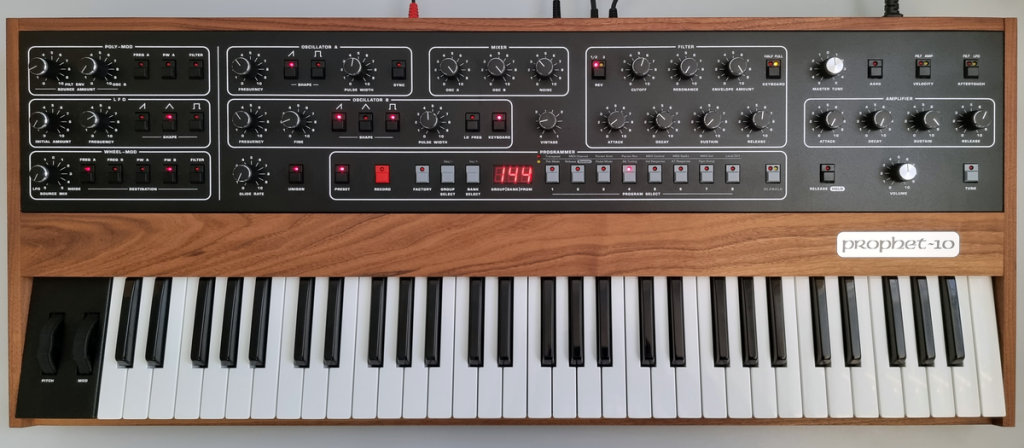
Dave Smith (1950 – 2022), educated in electrical engineering and computer science at the University of California, Berkeley, bought a MiniMoog in 1972. In San Francisco, in 1974, he made a hardware sequencer = a hardware device or software program that can record, edit or play back music, using note and other performance information, for himself. Then he made three other sequences, and sold them under the name Sequential Circuits. These four analog sequencers could be used with Moog and ARP synthesizers. In 1975, Sequential Circuits went on to make an unknown number of digital hardware sequencers, and then programmers, similar, but slightly more advanced devices that, can change the settings and other characteristics of a synthesizer. By 1976, aided by John Scott Bowen, these had become the Model 800 Sequencer, and Model 700 Programmer.
In 1977, the Prophet-5 started life as a Prophet-10, a synthesizer with ten voices of polyphony. It was unstable and overheated. This, in turn, made it difficult to tune. To construct a viable product, half of the electronics were removed, resulting in five voices of polyphony. It was renamed the Prophet-5. This machine was jointly designed by Smith and Bowen, with Bowen responsible for the sound design. Later, he created most of the Sequential’s sounds and sequences, and much of the User Interface (UI). The Prophet-5 was the first fully programmable polyphonic synthesizer and the first musical instrument with an embedded microprocessor, and a programmable memory. This allowed users to store sounds and access them instantly. It eliminated the need for a synth to be reprogrammed after even minor experimentation with sound. The Prophet-5 was especially praised for its ability to produce a standard package of familiar sounds. Between 1978 and 1984, about 6 000 units were produced.
After this, additional products were made including the Prophet-600 released in 1982 with a musical instrument digital interface (MIDI). In 1987, Sequential faced financial difficultires. It was purchased by Yamaha, who shut it down in 1989.
Smith then began working for Korg on the Wavestation synthesizer. In 2002, he started Dave Smith Instruments. That same year it released the Evolver synthesizer. In 2008, it released the Prophet ’08, an affordable eight-voice analog synthesizer. In 2015, Yamaha returned the Sequential Circuits brand name to Smith. In 2018 Smith released the Prophet-X, which featured sample playback and digitally controlled oscillators. On the 40th anniversary of the Prophet-5, (2018-08-31) Dave Smith Instruments rebranded as Sequential. Despite the release of a newer version of the Prophet-5 on 2020-09-30, it was announced on 2021-04-27 that Sequential had been acquired by Focusrite, a British audio company known for its audio interfaces.
Finding a suitable Prophet
In the text below, prices are stated in Norwegian kroner (NOK). To aid in conversion 1 CAD = 7.46 NOK; 1 € = 10.12 NOK; 1 USD = 9.45 NOK on 2022-06-04, on the date of this post’s publication.
Selecting a suitable Prophet is dependent on a person’s intentions and wealth. Those with the economic means who want to acquire an investment with extreme growth potential, probably should have bought an original Prophet-5 at least twenty years ago. If they are content with an ostentatious machine to intimidate others, these machines still offer opportunities.
Those a few rungs below on the economic ladder, content with impressing others, may want to consider a model, currently being made, a Sequential Prophet-10 Rev-4 Synth is being produced. The company is now owned by Focusrite. The synth costs about NOK 45 000. Its specifications include the use of some dated, but genuine, components, along with modern replacements, retaining the sound of the original Prophet-5, but with ten voices.
Musicians who simply want the sounds of a Prophet synth can usually obtain these cheaply, by using a clone or a virtual instrument.
One clone is a Behringer Pro-1 (NOK 3 000), a fairly rudamentary synthesizer based on the sounds of a Prophet-5, but with a single voice. It has numerous specifications that only synth fanboys understand or care about. There are claims that Behringer released a sixteen voice Pro-16 in 2021. I have not been able to find any information about it.
In terms of virtual instruments, Bowen worked for Native Instruments, to develop their Pro 5 software synthesizer emulator, released in 1999. It was followed by the Pro 52 in 2000 and the Pro 53 in 2003. He also contributed to Creamware’s Prophet and Prophet Plus emulators in 2003. Arturia released the Prophet V, in 2006. There are also totally free virtual instruments that can do almost the same, but these usually come without any guarantees.
For those more interested in experimentation than reproducing a marketable sound product, attention is directed to the Notes and Volts YouTube channel.
Note: Dave Smith died 2022-05-31.


As noted in this post, Sequential Circuits founder Dave Smith, died 2022-05-31. Here is a link to a 30m tribute video about him: https://www.youtube.com/watch?v=cyvbOYBBc2I